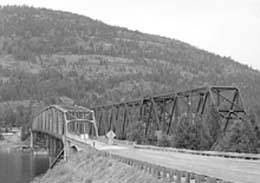On May 3, 1941, the Columbia River Bridge at Kettle Falls, near completion, opens to traffic. The steel cantilever bridge carries Route 395 across the river above the Grand Coulee Dam in the Kettle Falls vicinity of Stevens County. It is one of two highway bridges (and one railroad bridge) constructed to replace bridges flooded by waters rising behind the dam to form Lake Roosevelt. The Washington Department of Highways constructed the bridge, which has the longest central span of any highway bridge built in Washington state during the 1940s. In 1995 the steel truss bridge will be added to the National Register of Historic Places.
Unites States Bureau of Reclamation financed the bridge in conjunction with the Grand Coulee Dam -- Columbia Basin Reclamation Project. The bridge was completed (except for painting) in June 1941, not long after it opened to traffic. It was built beside a Great Northern Railroad bridge also financed by the Bureau of Reclamation. Both bridges were built upriver from the old 1929 highway bridge, which was taken down immediately after completion of the new bridge.
Washington Department of Highways awarded S. S. Mullen, Inc. the contract to build the reinforced concrete piers and the reinforced concrete T-beam approach spans. The approach spans were built on massive fill required to bring the road up to the level of the crossing. The main span piers rest on solid rock and required no pilings.
Washington Department of Highways awarded the L. Romano Engineering Co. of Seattle the contract to construct the riveted steel truss part of the bridge. The bridge has a through truss (the structure is cross-braced above and below the traffic). The sections of the structure, in order, are:
- approach span
- anchor arm
- cantilever arm
- suspended span
- cantilever arm
- anchor arm
- approach span
The two anchor arms are 225 feet long. The two cantilever spans leading from and supported by the anchor arms are 187 feet, 6 inches long, and the span suspended between the two cantilever arms is 225 feet long. The steel part of the structure is 1,050 feet long. The roadway is 24 feet wide and the bridge has a sidewalk cantilevered outside of the truss.
Before the building of the Grand Coulee Dam, Kettle Falls were 30-foot-high falls with rushing water and many flat rocks pocked with kettle-sized holes. For centuries it was a popular spot for Native Americans to trap and spear salmon during the summer and early fall months. Europeans began settling in the area in the 1840s, and the town of Kettle Falls was platted in the 1860s. By the 1890s the town was booming as settlers exploited its rich timber and agricultural resources.
The Grand Coulee Dam, completed in 1942, is one of the largest concrete structures in the world. The river backed up behind the dam flooded the falls and the townsite, which now lie under Lake Roosevelt. This is a 151-mile long reservoir section of the river spread over 82,000 acres.

